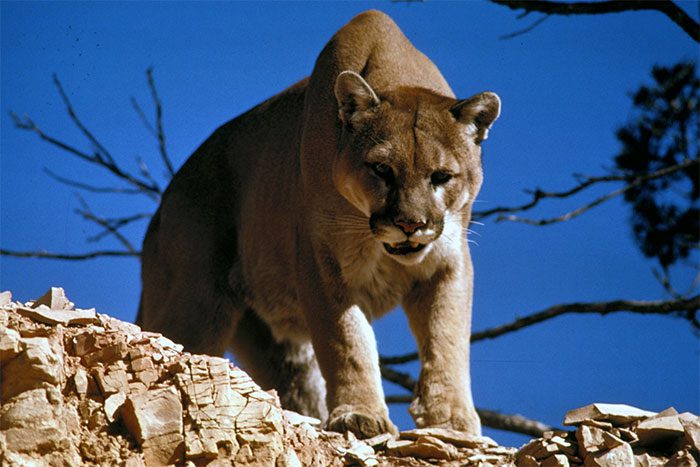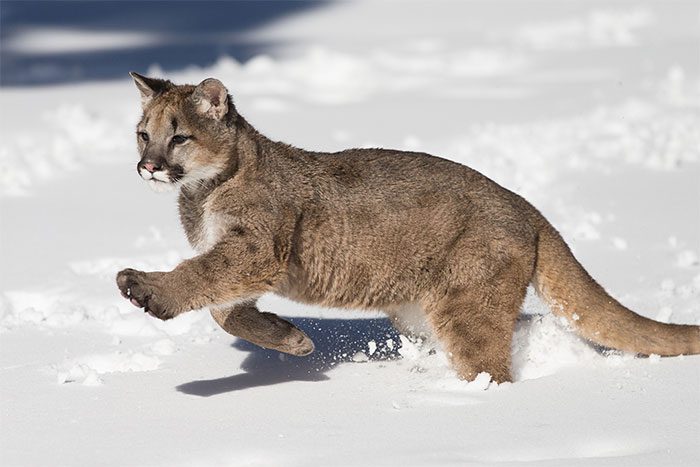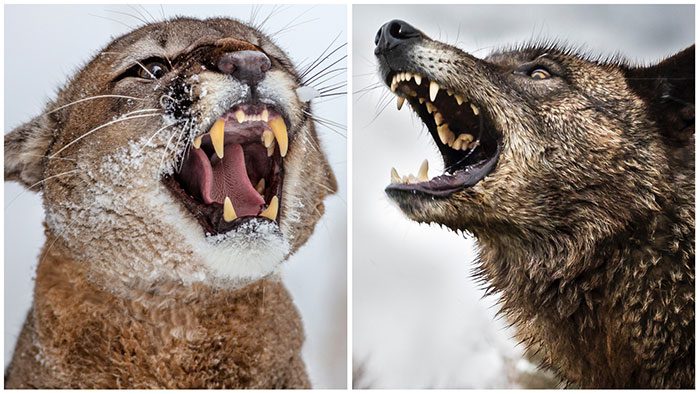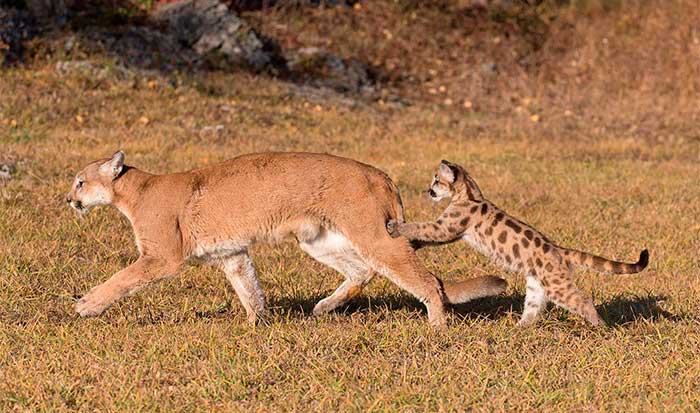In North America, wolves and cougars (mountain lions) are considered long-time neighbors and rivals. Both are apex predators and primarily target large hoofed animals as their main prey.
Food Wars
Wolves are slightly smaller than cougars, and in one-on-one combat, wolves cannot match the cougar. However, wolves have the advantage of living in packs. In North America, a wolf pack typically consists of 7 to 10 members, with some packs exceeding 20 individuals.
Wolves leverage their numbers to launch aggressive attacks against cougars, directly stealing food from them, which leaves the cougars feeling hungry and exhausted. This strategy ultimately aims to drive the cougars away.
Wolves can tell where a cougar has made a kill by the sounds of the prey, the scent of blood, and the circling crows overhead. To survive, cougars have no choice but to flee, abandoning the hard-won prey.
Experts have discovered that wolves stealing prey from cougars is a common occurrence. For instance, in Banff National Park, Canada, 40% of cougars’ prey eventually ends up in the paws of wolves, with 10% being directly stolen. Conversely, researchers have never recorded a case of cougars successfully stealing prey from wolves.

The wolf species is diverse, with various subspecies and sizes. The largest extant wolf is the Mackenzie Valley wolf of North America or Canadian Timber Wolf. They roam the northwest of the continent and frequently inhabit the Mackenzie River Valley (hence the name). Males of this subspecies can weigh over 200 pounds and have a bite strong enough to crush the bones of an adult moose. (Image: Zhihu).
Theft by wolves puts cougars in a difficult position, exhausting them and forcing them to hunt more frequently, expending additional energy. In the worst-case scenario, a cougar may sustain injuries while hunting. For a solitary predator, serious injuries that hinder hunting equate to death.
The Most Vulnerable: Female Cougars with Kittens
Under normal circumstances, a female cougar hunts every 11 days, while a female with kittens hunts every 6 to 7 days to feed her young. This intense hunting frequency is already near the limit, and if wolves steal her prey, both she and her kittens will starve.
Experts have found that in areas where wolves exist, cougars typically suffer from hunger and malnutrition.

Also known as mountain lions, pumas, panthers, or catamounts, large males typically weigh around 150 pounds. However, the largest cougars can exceed 200 pounds. The heaviest cougar recorded by the U.S. National Park Service weighed up to 276 pounds, but such individuals are extremely rare. Image: Zhihu
For example, in Banff National Park, although the annual mortality rate for wolves and cougars is about 50%, the majority of cougars die from natural causes unrelated to humans. Their bodies are often very emaciated and in poor nutritional health. In contrast, all wolf deaths are directly caused by humans, and the wolves that are killed are generally in good condition.
Similarly, in Yellowstone, in the years leading up to and shortly after the reintroduction of wolves, experts never found a single starving cougar.
However, a decade after wolves were introduced (after 2005), the local wolf population increased significantly, and experts began to regularly find dead cougars from starvation.
From 2005 to 2012, a total of 33 cases of deceased cougar kittens were recorded, with 10 cases of starvation, accounting for 30%; simultaneously, 45 adult and juvenile cougars were noted to have died, with 9 succumbing to starvation, constituting 20%.
This illustrates that wolf theft behavior leads to exhaustion and hunger in cougars, ultimately affecting their survival.

While cougars are solitary hunters, wolves hunt in packs. It is extremely rare for a lone wolf to take on a cougar. Image: Zhihu
More seriously, some cougars may not escape in time from the scene of a theft, and in such cases, they can be directly killed by wolves.
In December 1999, four years after wolves were reintroduced to Yellowstone, experts recorded the first instance of wolves killing a cougar. They learned from signals transmitted by radio collars that four kittens of a female cougar identified as F107 died within five days.
They rushed to the scene and found the carcass of a red deer killed by F107. A few hundred meters from the carcass, they discovered the bodies of two cougar kittens with distinct radio collars.
Experts reconstructed the entire sequence of these murders through traces in the snow and found that the mother cougar had initially killed a red deer and called her kittens to eat. Unbeknownst to her, the carcass attracted a wolf pack known as the Druid pack, which at the time consisted of four adults.
The wolf pack surrounded the mother cougar and her kittens, who, after being starved and desperate, fled. In the chaos, the mother became separated from her kittens, and two of them were caught and killed by the wolves on the spot.

In any one-on-one situation, wolves have no chance against cougars. When both are of similar or even differing sizes, a cougar will seize a wolf by the neck and tear it apart before it realizes what has happened. However, in the wilds of North America, wolves always act in packs. Image: Zhihu.
Subsequently, the wolf pack continued to search for nearby cougars, and five days later, two more cougar bodies were found, also killed by wolves.
Experts examined the body of one of the cougar kittens and found that although it had almost no external wounds, the internal injuries were severe, with ruptured organs and a pierced stomach.
The second recorded instance of a cougar being killed by wolves in Yellowstone occurred in April 2003. Based on signals from the radio collar, female cougar F106 had been motionless for 6 consecutive hours, leading Tony Ruth, an expert in the Yellowstone cougar research project, to conclude that the cougar was undoubtedly dead.

Illustration. Image: Zhihu
Autopsy results indicated that the female cougar had bite marks on her neck, internal organs scattered across the ground, and wolf fur in her mouth and on her paws, suggesting she had fought fiercely before being attacked by wolves.
At Glacier National Park, west of Yellowstone, numerous incidents of wolves killing cougars have also been recorded.
In January 1987, four wolves stole a white-tailed deer from a cougar. The female cougar escaped uninjured, but one of her kittens was surrounded and killed by the pack.
In December 1990, less than 2 kilometers from where the previous kitten was killed, the same pack killed an adult female cougar. At that time, the pack had grown to eight adult wolves.
From these examples, we can infer that occasionally, wolves do kill cougars, although most victims are young cougars, there are still instances of adult cougars being killed.


















































